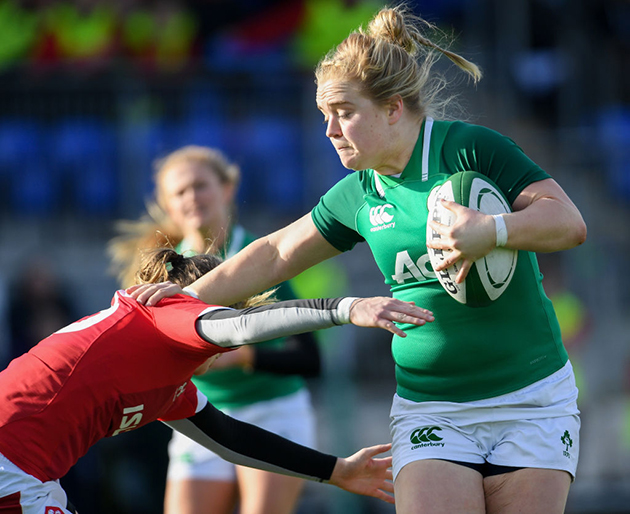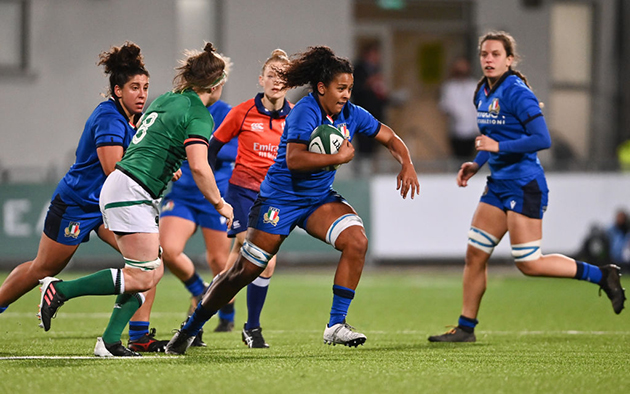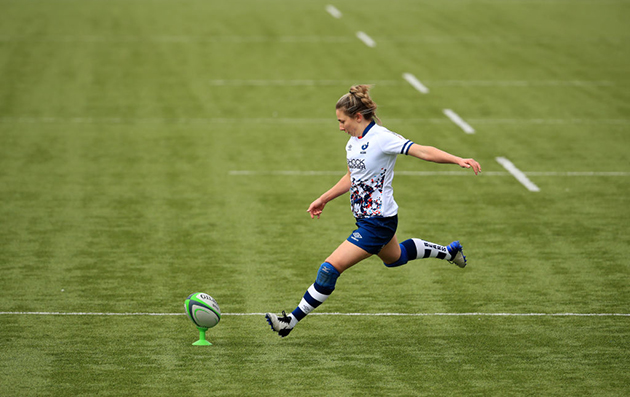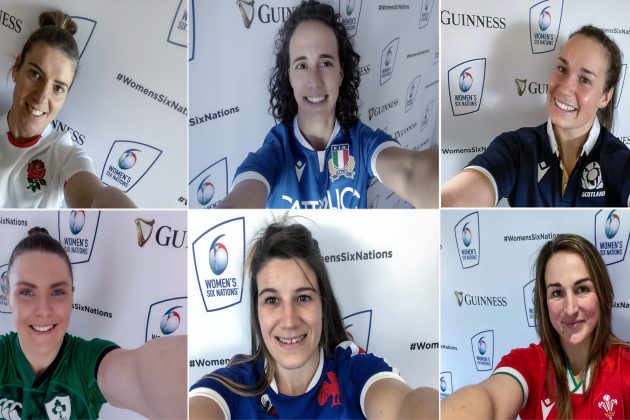All you need to know about the countries competing for this year’s championship title
Women’s Six Nations Team Guide 2021
There’s a new look to this year’s Women’s Six Nations. Not only has the championship switched to a standalone window in April – a move away from the men’s event that could become permanent – but it also has a different format for 2021.
Organisers opted to move the tournament to later in the year because of the challenges facing squads of mainly amateur players in light of Covid restrictions. It will be played on back-to-back Saturdays from 3 April.
Related: Women’s Six Nations Fixtures
The Six Nations will also have a condensed format, although this is expected to be a one-off for 2021. The six teams have been split into two pools, each playing one home and one away fixture with a bye weekend during the group stages. Then they will play the team ranked in the same position as them in the other pool table on a ‘finals weekend’ on 24 April.
Pool A consists of England, Italy and Scotland while France, Ireland and Wales are in Pool B – and below we run you through all the teams.
Related: New format for 2021 Women’s Six Nations
Women’s Six Nations Team Guide
ENGLAND
The Red Roses come into this championship with back-to-back Grand Slams but without their veteran fly-half.
Katy Daley-Mclean announced her retirement from Test rugby at the end of last year having won 116 caps since her debut in 2007, so Zoe Harrison, Meg Jones and Helena Rowland are now set to battle it out for the No 10 shirt in this Six Nations in the hope of becoming first-choice fly-half for the World Cup, which has been postponed until 2022.

Jess Breach takes a selfie with her team after England’s Grand Slam last year (Getty Images)
Harrison has long been lined up as the successor but more recently has been playing at inside-centre at Test level, Rowland’s creativity was evident during her debut campaign last autumn and Jones’s form for Wasps means she is in contention too.
Whoever plays at fly-half – and Simon Middleton could opt to give different players a start during the championship – they have the benefit of playing behind an outstanding set of forwards.
England’s pack will expect to dominate at the set-piece, even without prop Sarah Bern (shoulder injury), while the likes of Poppy Cleall and Shaunagh Brown also make significant ground with ball in hand.
Key player
It’s an obvious one but it’s hard to look beyond Emily Scarratt, particularly now that Daley-Mclean has retired. Scarratt has always played an integral role in the Red Roses back-line and her experience will be key in supporting whoever is at ten.
Her goalkicking is superb (she is England’s record point-scorer), she’s a powerful runner who breaks the gain-line (she made more metres than any other player in 2020), she’s uncompromising in defence and her vision sets her apart.
It’s little wonder she was named the first Women’s Six Nations Player of the Championship last year, a title to add to her 2019 World Player of the Year gong.
One to watch
Ellie Kildunne, 21, returned to 15s this season after the sevens programme was cut and has impressed at full-back for both Wasps and England. A gliding runner with a decent boot, she will exploit any chinks in defences.
?? Quickfire passes from @EnglandRugby and a score for @elliekildunne! ?
⏱️ this time next week the Red Roses will be back on the pitch!! ?#WomensSixNations pic.twitter.com/qONQBwmkzh
— Women's Six Nations (@Womens6Nations) March 27, 2021
Vital statistic
England’s defence was miserly last year as they conceded just 20 points in their five Six Nations matches. The fact they scored 219 points meant their points difference was 199!
FRANCE
France waltzed to a Grand Slam in 2018, but they have struggled to find that consistency since. In 2019, they were stunned by Italy in the final round of the Six Nations before they themselves stunned the Black Ferns 25-16 a few months later.
Last year they dismantled Wales and Italy but stumbled to a 13-13 draw with Scotland and lost three times to England. The most recent defeat by the Red Roses will have been the most painful as they were in a commanding position at Twickenham before conceding a last-minute penalty.
The biggest challenge for Annick Hayraud and her coaching team is to instil the mindset that sees players deliver across the 80 minutes.
There are quality players throughout the France squad – Jessy Tremouliere, Cyrielle Banet, Laure Sansus and Marjorie Mayans among them – but a little less chopping and changing when it comes to selection might allow them to build a better game understanding.

Cyrielle Banet scores against England last November (Getty Images)
In the plus column is the fact that club rugby returned after a four-month break in mid-February, so players have been able to sharpen skills and build match fitness before the Six Nations.
Key player
The fact Gaelle Hermet was made captain of France at just 21 gives you an idea of her leadership credentials and importance to the team.
The Toulouse back-rower has been in the role for more than three years now and drives her team forward with deeds as much as words. She’s a threat with ball in hand and is strong defensively, be it making tackles or winning turnovers.
One to watch
Rose Bernadou comes from a rugby family but her rise to Test honours came quicker than expected as she made her debut against Scotland last autumn.

France prop Rose Bernadou carries against Scotland (AFP/Getty Images)
The prop, 22, is known for her powerful runs but she also likes the more unseen work of her role at the scrum and breakdown.
Vital statistic
France are on a seven-match losing streak against England, who they will also meet in the pool stages of the next World Cup in New Zealand.
IRELAND
Anthony Eddy, the IRFU director of women’s rugby, has spoken of finding the positives in tournament delays and match cancellations, pointing to having more preparation time and the players’ “commendable attitude and resilience”. Yet there must be serious concerns around exactly how well prepared the team will be for the Six Nations.
They have played just one Test in the last 12 months and the majority of their players haven’t had any other games because club rugby in Ireland has been suspended due to the pandemic.
Yes, they have a handful of players performing in the Premier 15s, but most of Adam Griggs’s squad have been limited to training sessions.
They have looked to add a competitive element to those camps, with lots of game scenarios and internal matches, but nothing can replicate a Test.
There’s no shortage of talent, older heads like Claire Molloy, Ciara Griffin and Sene Naoupu complemented by youngsters Dorothy Wall and Beibhinn Parsons. But their fortunes in this tournament will hinge on whether they can hit the ground running.
Key player
Being named Women’s Player of the Year at the 2020 Rugby Players Ireland Awards is testament to Cliodhna Moloney’s progress.

Cliodhna Moloney tries to evade Wales’ defence (Sportsfile/Getty Images)
The 27-year-old hooker is not only impressive in the set-piece exchanges but she has a knack for producing game-changing moments – she scored two tries and won four turnovers in last year’s championship, the best return of any Ireland player. Plus, as a regular at Wasps she has the benefit of being ‘match fit’.
One to watch
Beibhinn Parsons is the youngest Ireland international in history, making her debut off the bench against the USA in 2018 aged just 16. The winger is still a teenager but is a regular in the Ireland team and scored tries against Scotland and Wales last year.
Ireland will look to get the most out of the powerful runner, who not only has pace but the ability to change direction at speed. Better weather conditions in this new window should help with that.
Vital statistic
Ireland are the only team to have broken the England-France duopoly on the Six Nations in the past 20 years, winning the title in 2013 (Grand Slam) and 2015.
ITALY
Following an historic second-place finish in 2019, when they stunned France 31-12 in their final game, the Azzurre were unable to back it up last year. They won just one of the four matches they played, a 19-15 victory in Wales, and were thumped 54-0 by England in the final round.
On the positive news front, Italy haven’t suffered any serious injury blows and have welcomed back Manuela Furlan. The captain was sorely missed last spring but returned for the delayed fixtures last autumn and is raring to go this season.

Sara Barattin clears against England (Inpho)
Coach Andrea Di Giandomenico highlighted “a lack of precision” in their 21-7 loss to Ireland in October and was hoping for a more aggressive defence against England, but instead they were whitewashed by the Red Roses in Parma.
They start this season’s championship against the same opposition so have an opportunity to address those areas and show improvements, albeit that England remain overwhelming favourites. It could be a difficult campaign for Italy, with a lack of game time again an issue.
Key player
Scrum-half Sara Barattin and full-back Manuela Furlan bring plenty of experience, but it’s Giada Franco in the back row who is becoming a real spark for this Italy team.
She’s still only 24 but enjoyed a breakthrough campaign two years ago, with her ability to give Italy front-foot ball crucial to securing second spot.

Back-rower Giada Franco is an important figure in the Italy squad (Sportsfile/Getty Images)
Her time at Harlequins helped develop her game and she enjoys her all-court position, saying: “Back-row is the best role in rugby. You have to be good in defence but good in attack as well. It’s the most complete role in rugby.”
Italy will need her to tick all those boxes if they are to secure any wins in this condensed tournament.
One to watch
Vittoria Ostuni Minuzzi, who plays her club rugby for Valsugana Padova, made her Italy debut in last year’s Six Nations and was involved in all four matches.
The 19-year-old cites speed as one of her strengths and she put that to good use by making more metres than any other Italy back in the 2020 tournament. In fact, her and Franco were the only Italians to make more than 200 metres.
Vital statistic
Italy impressed at the breakdown in the 2020 championship, with Elisa Giordano (seven) and Michela Sillari (five) winning more turnovers than any other players.
SCOTLAND
The pandemic has affected all teams but Scotland arguably had the worst of it in 2020.
They were only able to play two games in the original Six Nations window before being hit by postponements, then they lost their coach Philip Doyle, who had to shield on medical grounds. Just as they were building some momentum with a confidence-boosting 13-13 draw with France in October, their remaining championship games got cancelled.
Scottish Rugby have been investing more in their women’s programme, with qualifying for the next World Cup (now in 2022 rather than 2021) the big goal having failed to make it to the 2014 and 2017 tournaments.
There have been signs of improvement – that draw with France significant – but they’re still searching for their first Six Nations win since 2018 and must make further strides if they’re to get to New Zealand.
Bryan Easson has stepped up to the head coach role, with a contract until RWC 2025, and he has talented players at his disposal – Lisa Thomson, Chloe Rollie and Rachel Malcolm have stood out in recent years.
But they need to become more competitive as a collective against higher-ranked sides – and the loss of Jade Konkel is a big blow. The No 8, whose powerful carries far more often than not got her over the gain-line, is taking a break from rugby to become a firefighter.
Key player
Other players will need to step up in Konkel’s absence and captain Malcolm has been full of praise for centre Lisa Thomson.
“She’s the most well-rounded player we have in the team,” says Malcolm. “She’s world class as a centre and for Scotland to play well Lisa Thomson is usually on the money as well.”
Right below the posts for @Scotlandteam ??????? and Thompson! ?
Who are you most looking forward to watching this #WomensSixNations? ⤵️ pic.twitter.com/BUKtiEZ1Jj
— Women's Six Nations (@Womens6Nations) March 29, 2021
One to watch
Big things are expected of Leah Bartlett, the 22-year-old loosehead who made her Scotland debut last year.
She has been playing since the age of five, is part of the Loughborough Lightning Premier 15s squad and was involved in the England U20 set-up before representing the land of her parents.
Vital statistic
No 8 Jade Konkel made 77 carries in last year’s Six Nations – more than any other player. It’s a remarkable stat when you consider Scotland played only three matches. As a comparison, CJ Stander was the top carrier in the 2020 men’s Six Nations with 78 but that was across five games, so he had an average of just over 15; Konkel was averaging 25! That’s what Scotland will be missing this year.
WALES
Over the past few months, it’s been all change in Wales’ coaching box. Warren Abrahams is the new head coach, with Geraint Lewis now in charge of the forwards. Sophie Spence, an ex-Ireland lock, has joined the back-room team as a ‘coaching intern’ while Darren Edwards has come in as skills coach following former captain Rachel Taylor’s recent resignation.
As Spence told Rugby World, the philosophy is “positive vibes only” under South African Abahams, who has been described as “inspirational” by captain and back-row Siwan Lillicrap.
Yet Wales need to ensure that inspiration is evident on the pitch, given that they lost all four of the Six Nations matches they played last year, conceding an average of more than 40 points a game.
Qualifying for the next World Cup by finishing seventh at the 2017 edition has meant Wales have been able to trial different combinations and test youngsters in recent seasons. The postponement of the global tournament until 2022 now gives Abrahams the chance to nail down his first-choice XV and develop his game plan in this Six Nations.
Gelling is even more challenging given that they haven’t played a Test for more than a year. Many Welsh players are benefiting from regular game time in the Premier 15s, but notable improvements are needed at international level if they are to avoid more hefty scorelines.
Key player
Abrahams has spoken of Wales finding their “X-factor”, which should suit Elinor Snowsill. The Bristol fly-half, who missed last year’s Six Nations with injury, is one of Wales’ most experienced players and is known for flair.
If Wales are to create chances for the likes of Jasmine Joyce and Hannah Jones, they need Snowsill at her instinctive best, especially on April’s firmer pitches.

Elinor Snowsill kicks at goal for Bristol Bears (Getty Images)
One to watch
Manon Johnes turned 20 in December but has been in the national set-up for three years and balances rugby with studying geography at Oxford. Expect the back-rower to excel in both the tight and the loose with her skill-set, which has seen her play on the sevens circuit.
Vital statistic
Alisha Butchers made 72 tackles in last year’s championship. She was one of four Welsh players in the top five along with Siwan Lillicrap (69), Beth Lewis (62) and Gwenllian Pyrs (62), although only Lillicrap is in this year’s squad.
Don’t miss a game with this Women’s Six Nations TV coverage guide.
Can’t get to the shops? You can download the digital edition of Rugby World straight to your tablet or subscribe to the print edition to get the magazine delivered to your door.
Follow Rugby World on Facebook, Instagram and Twitter.





